A Guide to the Biomes of the World
Explore the biomes of the world in our complete guide. Discover the unique climates, plants, and animals that define Earth's major ecosystems.
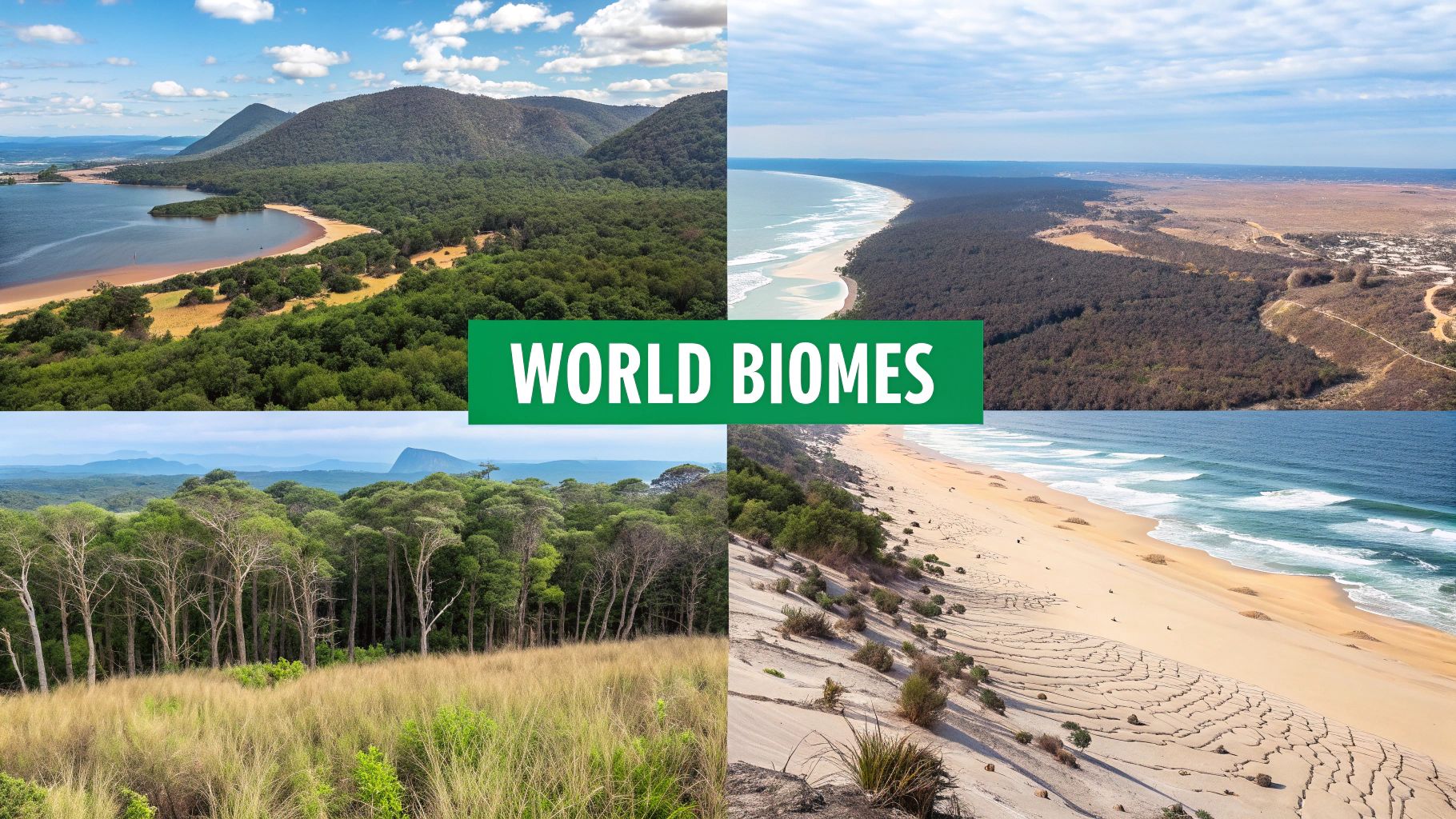
Think of our planet as a massive patchwork quilt. Each patch—a steamy rainforest, a sun-baked desert, a windswept grassland—is a unique biome. It's a huge community of plants and animals that have all adapted to live in a specific climate.
What Defines the Worlds Biomes
Let's stick with the idea of a neighborhood. Every biome is like a giant, distinct neighborhood on Earth. It has its own climate, a unique cast of residents (all the flora and fauna), and a specific set of rules for survival.
What determines the character of these global neighborhoods? It really boils down to two key factors: temperature and precipitation. These two ingredients dictate everything, from the richness of the soil to the kinds of life that can carve out an existence there.
These biomes aren't just one-off locations; they're patterns that repeat across the globe. A desert biome, for instance, isn't just found in Africa. You’ll find similar arid "neighborhoods" in Australia, the Americas, and Asia. Even on different continents, they all share the classic desert blueprint: very little rain and often extreme temperatures.
The Two Major Categories
To make sense of it all, scientists start by splitting the world's biomes into two big buckets: terrestrial (land-based) and aquatic (water-based). This simple split is the first step in organizing our planet's incredible biodiversity into a framework we can actually understand.
It's easy to mix up biomes and ecosystems, but there's a key difference. An ecosystem can be as small as a single pond. A biome is a much, much larger region that can contain thousands of different ecosystems within it.
The infographic below gives you a bird's-eye view of how scientists classify these global environments.
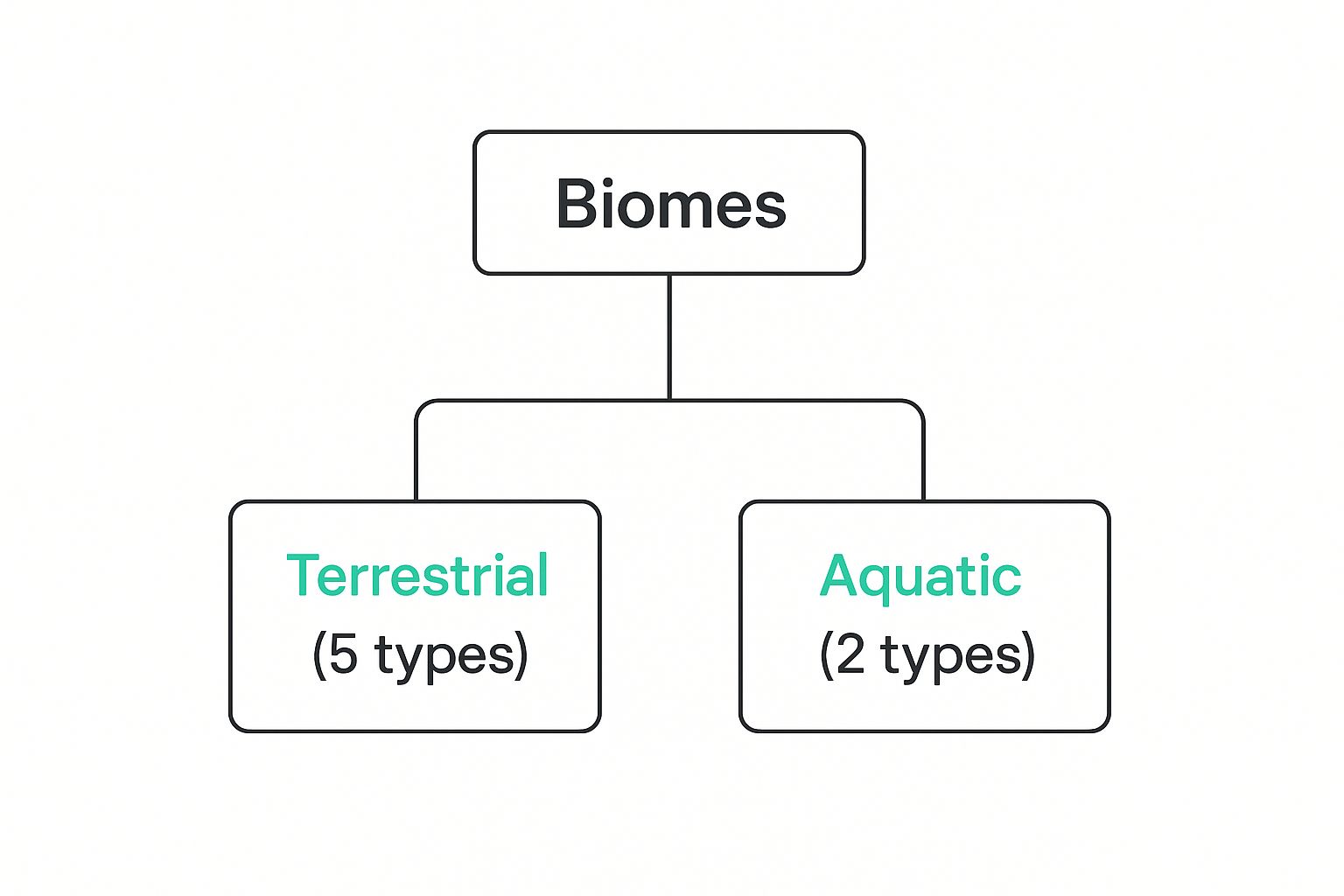
As you can see, every place on Earth that supports life fits into either the terrestrial or aquatic category before we drill down into more specific types. Grasping this basic hierarchy is the foundation for mapping out our planet’s complex and deeply interconnected living systems.
Major Terrestrial Biome Categories at a Glance
Before we dive deep into each specific biome, this table gives a quick summary of the major land-based categories. It’s a great way to get a feel for the core concepts at a high level.
| Biome Category | Key Climate Characteristics | Dominant Vegetation |
|---|---|---|
| Forests | High precipitation, varied temperatures | Trees (deciduous, coniferous, tropical) |
| Grasslands | Moderate rainfall, distinct seasons | Grasses, non-woody flowering plants |
| Deserts | Very low precipitation, extreme temperatures | Cacti, succulents, hardy shrubs |
| Tundra | Cold, dry, short growing seasons | Mosses, lichens, low-growing shrubs |
This simple breakdown shows how just a few climate rules can create vastly different environments, from dense forests to frozen plains.
Journey Through the World's Forest Biomes
Forests are the living, breathing lungs of our planet, covering nearly a third of all land on Earth. But a forest in the Amazon is a world away from one in Siberia. Climate is the master architect here, sculpting vastly different wooded landscapes, each teeming with life that has adapted to its unique rules.
Our exploration of the world’s biomes starts here, under the canopy of these vital, tree-dominated worlds.
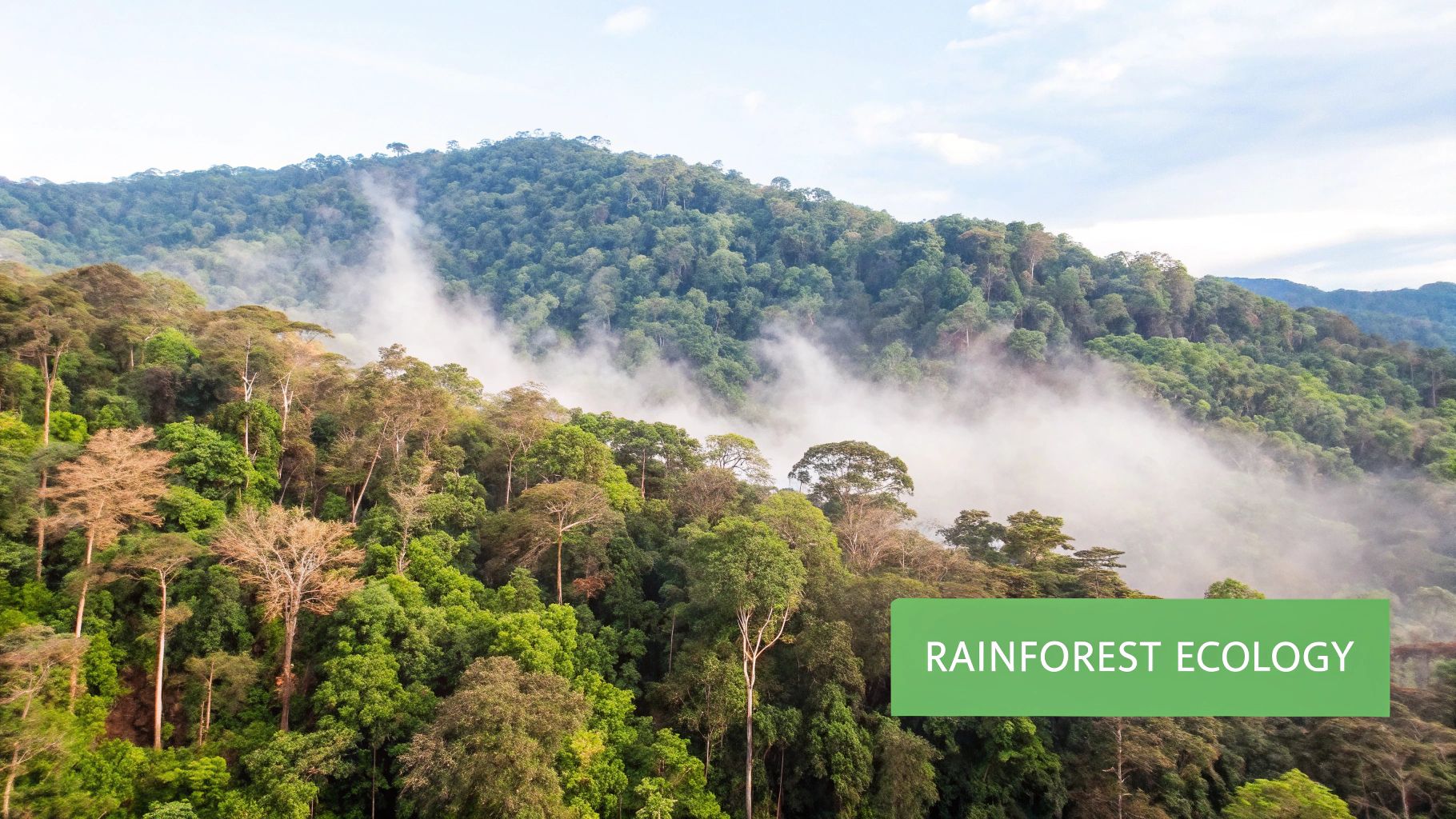
The Lush World of Tropical Rainforests
Picture a world of constant warmth and near-daily downpours, where life practically explodes from every surface. That’s the tropical rainforest, the most biodiverse land biome on the planet. You'll find these vibrant powerhouses hugging the equator in places like South America's Amazon Basin, Central Africa, and Southeast Asia.
Think of a rainforest as a high-rise apartment building for plants and animals, with four distinct floors:
- Emergent Layer: The towering giants that poke above the rest, soaking up the full force of the sun.
- Canopy Layer: A thick, interlocking ceiling of leaves that forms a green roof, capturing most of the sunlight.
- Understory Layer: A dim, humid space below the canopy where smaller trees and shrubs adapted to low light survive.
- Forest Floor: The dark, damp ground level where fungi and insects work overtime to decompose fallen leaves and branches.
This layered structure creates countless homes for an unbelievable variety of species—from poison dart frogs and jaguars to spider monkeys and macaws. In fact, while tropical rainforests cover only about 7% of the Earth's land, they are responsible for roughly 30% of the planet's net primary productivity (NPP), the measure of how much new life plants create.
The Ever-Changing Temperate Forests
As we move away from the equator, we step into the temperate deciduous forests. For many of us, this is the forest we know best, a landscape defined by the familiar rhythm of four distinct seasons. Spanning across the Eastern United States, Western Europe, and parts of East Asia, these biomes put on a spectacular show of change year after year.
The main characters here are the deciduous trees—oaks, maples, and beeches. They’ve mastered a brilliant survival strategy for the cold winters: they drop their leaves in the fall to save energy and water, bursting forth with new growth every spring.
This seasonal pulse dictates the lives of animals like white-tailed deer, black bears, and squirrels. Some hibernate through the cold, while others spend autumn frantically storing food to survive the lean months. Each fall, the decaying leaves enrich the soil, creating a fertile foundation for the explosion of wildflowers and ferns that carpets the forest floor in spring.
The Resilient Boreal Forests or Taiga
Our last stop takes us to the far north, into the immense boreal forest, also known as the taiga. This biome is simply massive, forming a continuous belt across Canada, Alaska, Scandinavia, and Siberia, making it the world's largest land biome. Life here is all about endurance, shaped by long, brutal winters and short, fleeting summers.
You won't find broadleaf trees here. The taiga is the kingdom of tough coniferous trees.
Think of pines, spruces, and firs. Their needle-like leaves are experts at minimizing water loss, and their classic cone shape helps them easily shed heavy snow—perfect adaptations for this harsh climate.
The forest floor is a spongy carpet of mosses and lichens, and the soil beneath is acidic and nutrient-poor. The animals are just as tough. Moose, lynx, and caribou roam these quiet, cold forests, while creatures like the snowshoe hare change their fur from brown to white, vanishing into the winter landscape.
The stark beauty of the taiga is a powerful reminder of nature’s ability to thrive under pressure. Its sheer size also makes it a critical carbon sink, quietly helping to regulate the global climate. If these grand-scale ecosystems fascinate you, you might also enjoy our guide on the natural wonders of the world.
Exploring Open Landscapes: Grasslands and Shrublands
Let's leave the dense forests behind and step out into the wide-open spaces of the grasslands and shrublands. These are the biomes where the sky just goes on forever, the horizon feels a million miles away, and life is constantly shaped by sun, wind, fire, and seasonal rains. They’re so much more than just empty fields of grass; these are incredibly dynamic and complex systems.
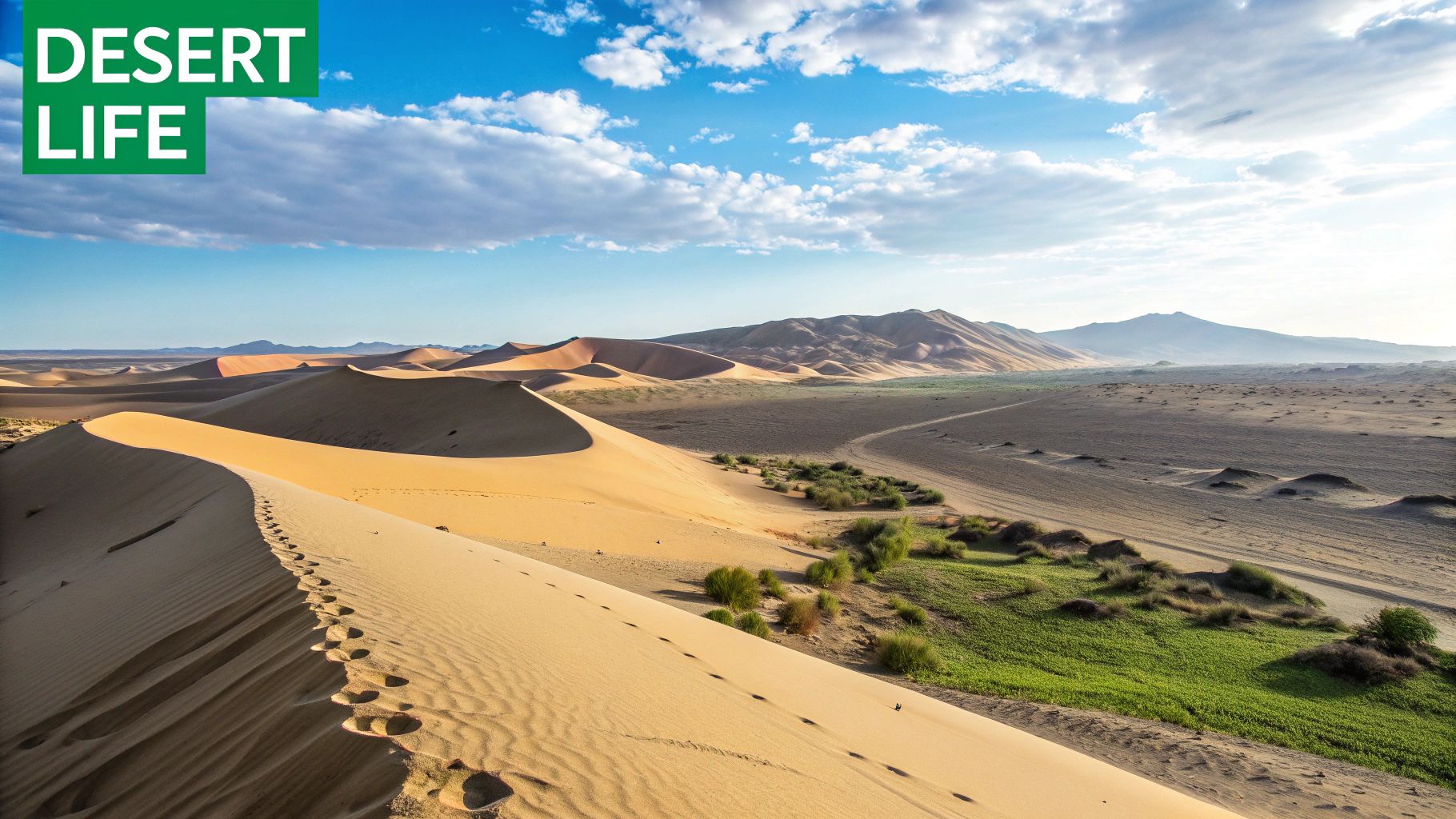
Unlike forests, these areas don't get quite enough rain to support a full canopy of trees. But they're not nearly as dry as a desert, either. This "just right" amount of water is the perfect recipe for grasses and tough, hardy shrubs to completely dominate the landscape.
The Iconic African Savannas
When you picture a classic grassland, you're probably imagining a tropical savanna. You'll find these incredible landscapes in Africa, Australia, and South America, and they are all defined by one thing: a powerful wet and dry season. It's a true feast-or-famine climate, where months of torrential downpours are followed by long stretches of intense drought.
This climate cycle is what gives the savanna its signature look—a vast sea of grass dotted with fire-resistant trees like the iconic flat-topped acacia. The wildlife here has built its entire existence around this seasonal rhythm. Massive herds of wildebeest, zebras, and gazelles embark on legendary migrations, constantly chasing the rains to find fresh grass to eat.
And, of course, where you find grazers, you'll find predators. Lions, cheetahs, and hyenas are the top hunters of this biome, and they play a crucial role in keeping the herbivore populations healthy and in check. The savanna is also home to giants like elephants, giraffes, and rhinos, setting the stage for some of the most dramatic wildlife spectacles on the planet.
The Fertile Temperate Grasslands
As we move away from the equator, the grasslands change. We enter the temperate grasslands, known by different names around the world—prairies in North America, steppes in Eurasia, and pampas in South America. These biomes have a much bigger temperature swing, with scorching summers and frigid winters. But their defining feature isn't just the grass; it's the amazingly rich, deep soil that lies beneath it.
For thousands of years, the cycle of deep-rooted grasses growing and decomposing has created some of the most fertile agricultural land in the world. This is exactly why so much of the original prairie has been converted into farmland, earning these regions the nickname "the world's breadbasket."
Historically, these grasslands supported mind-bogglingly large herds of grazers like the American bison. Their constant grazing was actually essential to the ecosystem's health. Their hooves would break up and aerate the soil, while their munching prevented any single type of plant from taking over, which in turn boosted biodiversity.
Fire is a key architect of all grassland biomes. Naturally occurring fires, often started by lightning, sweep through the landscape, clearing out dead plant matter and preventing trees from encroaching. The grasses themselves are built to survive, with deep root systems that quickly send up new shoots after a burn.
The Fire-Forged Chaparral
Finally, we arrive at a unique kind of shrubland called the chaparral, or Mediterranean biome. Found in coastal areas like Southern California, the Mediterranean basin, and parts of Australia, this biome has a very particular climate: hot, bone-dry summers and mild, rainy winters.
The plants here are tough customers—mostly evergreen shrubs and small trees with waxy leaves that are masters at holding onto water during the long, rainless summer. Think of plants like sagebrush, manzanita, and scrub oak. This dry vegetation, combined with hot and windy conditions, makes the chaparral extremely susceptible to fire.
But here's the twist: fire isn't a disaster here. It's a vital part of the life cycle, and many chaparral plants have evolved to depend on it.
- Fire Followers: Some plants have seeds that absolutely will not germinate until they've been exposed to the intense heat or smoke from a wildfire.
- Rapid Regrowth: Other shrubs are built to resprout almost immediately from their root crowns after their tops have been completely burned away.
This cycle of fire clears out the old growth, pumps nutrients back into the soil, and makes way for a whole new generation of plants to burst forth. Animals like coyotes, jackrabbits, and many bird species have perfectly adapted to this dynamic, fire-shaped world.
How Life Thrives in the World's Extremes: Deserts and Tundra
Leaving the familiar grasslands behind, we now plunge into the planet’s most unforgiving environments. These are the biomes of the world where survival isn't just a skill—it's a masterpiece of evolution, pushing life to its absolute edge. First up, the deserts: vast landscapes defined not by heat, but by an overwhelming lack of water.
It's a common mistake to think all deserts are scorching hot. While many are, like Africa's Sahara, a desert's true identity comes from its dryness. A desert is any place that gets less than 10 inches (25 centimeters) of rain a year. That means some deserts, like the Gobi in Asia, are actually bitterly cold.
Survival in the Driest Places on Earth
Life in the desert is a relentless search for water. The plants and animals here have devised some truly incredible tricks to find, store, and hold onto every single drop. This is a world built for efficiency and pure grit.
Many desert creatures have solved the heat problem by simply avoiding it. They're nocturnal, spending the blistering day in cool underground burrows and only coming out at night to hunt and forage. The fennec fox is a perfect example; its enormous ears aren't just for listening, they're personal radiators that help it shed body heat.
Desert plants are just as clever. Cacti are the obvious superstars, with their thick, waxy skin to stop evaporation and a network of shallow roots ready to soak up any rare shower. They traded leaves for spines, which not only protect them from thirsty animals but also drastically cut down on water loss.
Deserts blanket about 20% of the Earth's surface, making them a massive part of our planet's story. The adaptations here are some of the most specialized and mind-blowing examples of evolution you'll ever see.
The Frozen World of the Tundra
Now, let's jump from one extreme to another—from the driest places to the coldest. Welcome to the tundra. Stretching across the high northern latitudes of North America, Europe, and Asia, this is Earth's coldest biome, a vast, treeless plain where the conditions are nothing short of brutal.
The tundra's defining feature is permafrost, a layer of soil just beneath the surface that stays frozen solid all year round. This icy barrier prevents trees from growing deep roots and stops water from draining away, creating a unique landscape of low-growing plants and soggy ground during the brief summer.
The growing season is incredibly short, lasting only about 50 to 60 days. But in that tiny window, the tundra explodes with life.
- Hardy Flora: You won't find any towering forests here. Instead, the ground is a carpet of mosses, lichens, sedges, and dwarf shrubs that hug the ground for warmth and to escape the constant, biting wind.
- Resilient Fauna: Animals like caribou (reindeer), musk oxen, arctic foxes, and snowy owls have adapted with thick fur coats and layers of insulating fat. Many, like the caribou, embark on epic migrations to find food as the seasons turn.
Life in the tundra is a powerful lesson in resilience. Every organism has evolved to make the most of a fleeting summer and to endure a long, dark, and frozen winter. For EarthChasers players exploring these polar regions, capturing that stark, windswept beauty and understanding these survival strategies will be your key to mastering these challenging virtual environments.
Understanding Our Planet's Aquatic Biomes
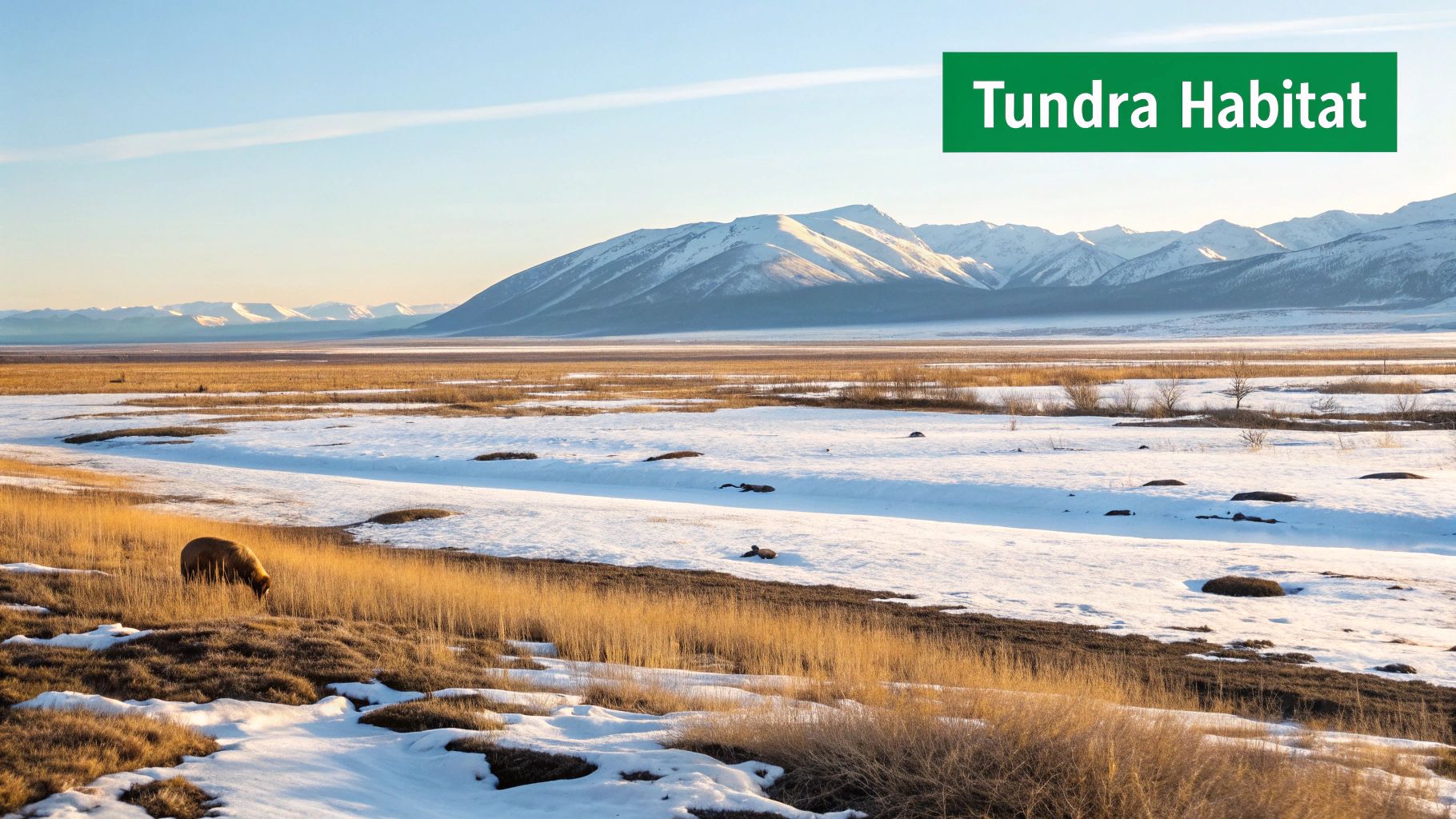
It's easy to get caught up in the incredible diversity of Earth's land-based biomes, but we often forget a staggering fact: over 70% of our planet is covered in water. These aquatic biomes are just as complex and vital as any forest or desert, from the tiniest creek to the deepest ocean trench.
All this water is broadly split into two major groups, and the difference comes down to one simple but critical ingredient: salt content. This gives us our two main categories—freshwater biomes with very low salt, and marine biomes with high salinity. Each one hosts a unique web of life perfectly tuned to its specific water chemistry.
Exploring Freshwater Biomes
Think of freshwater biomes as the planet's circulatory system. They're the rivers, lakes, streams, and wetlands that weave across our continents. Even though they cover less than 1% of the Earth's total surface, their importance for both wildlife and human civilization is off the charts.
Let's break down these critical water worlds:
- Rivers and Streams: These are dynamic, moving bodies of water. Life here is built for the current—think of a trout with its streamlined body, built to navigate the flow. The environment changes dramatically from the cold, clear headwaters down to the warmer, slower mouth.
- Lakes and Ponds: In these still waters, life is all about depth. The sunlit shallows are packed with plants, while the darker, deeper zones host creatures that survive on organic matter sinking from above.
- Wetlands: These are soggy zones where land and water meet, like marshes, swamps, and bogs. Wetlands are true workhorses, acting as natural water purifiers and serving as crucial nurseries for countless fish, birds, and amphibians.
Diving into Marine Biomes
Now, let's plunge into the colossal world of marine biomes. As the largest of all biomes, this saltwater realm isn't one single environment but a collection of distinct zones, each with its own rules and residents. The sheer scale here is mind-boggling, making these ecosystems the primary drivers of our global climate.
The ocean is so vast that it soaks up a huge amount of the sun's heat and atmospheric carbon dioxide. This process helps regulate temperatures and weather patterns across the entire planet, which is why marine health is truly a global concern.
Marine biomes are usually categorized by water depth and how close they are to land.
- Coral Reefs: Often called the "rainforests of the sea," these are vibrant cities built by tiny animals. You'll find them in warm, shallow waters, where they support a stunning level of biodiversity—providing a home for roughly 25% of all marine species.
- Estuaries: These are unique mixing zones where freshwater rivers flow into the salty ocean. This blend of waters creates a nutrient-rich soup, making estuaries vital habitats for the young of many commercially important fish and shellfish.
These underwater worlds are incredibly complex. To explore them in more detail, you can dive into our guide on the diverse oceans and seas of the world. For EarthChasers players, modeling these aquatic zones means getting a feel for the delicate balance of salinity, sunlight, and currents that shapes life beneath the waves.
How Climate Change Is Reshaping World Biomes
The map of the biomes of the world we’ve explored isn't set in stone. Think of it less like a permanent atlas and more like a live weather map, where the boundaries are constantly shifting. Climate change is the powerful force pushing these boundaries, fundamentally rewriting the rules that have governed these vast ecosystems for thousands of years.
As global temperatures climb and rainfall patterns become more erratic, biomes are being pushed to their absolute limits. It’s like turning up the thermostat in a house—some residents might adapt, but others will have to move or face being pushed out entirely. The same thing is happening on a planetary scale.
The Great Biome Migration
Ecosystems are on the move, triggering massive transformations across continents. Scientists are already observing these dramatic shifts. For instance, warmer temperatures are allowing temperate forests to creep northward into the traditionally colder taiga, while some grasslands on the edge of deserts are slowly losing their battle against expanding arid conditions.
This isn't a simple or clean process. It’s a messy, high-stakes reshuffling of life on Earth, driven by a climate that’s changing faster than many species can keep up.
A critical concept here is biome inertia—the time lag between when the climate shifts and when the ecosystem actually responds. A forest can't just pick up its roots and move overnight. This delay creates a growing mismatch between the climate of a region and the biome that currently exists there, putting immense stress on local plants and animals.
The Most Vulnerable Landscapes
While all biomes are feeling the heat, the planet's colder regions are on the front lines, showing the most dramatic signs of distress. These environments are warming much faster than the global average, unleashing rapid and often irreversible changes.
Two biomes are particularly at risk:
- The Tundra: Permafrost, the tundra's defining feature, is thawing. As this frozen ground melts, it destabilizes the entire landscape and releases huge amounts of trapped greenhouse gases like methane and carbon dioxide, which in turn speeds up the warming.
- Boreal Forests: These massive northern forests face a triple threat: more frequent and intense wildfires, insect outbreaks, and crushing drought stress. Warmer, drier conditions are creating a perfect storm for destruction on a scale we've never seen before.
The potential fallout is staggering. Projections show that if current trends continue, the climatic conditions that support many existing biomes could vanish from huge areas of the globe. For example, research suggests that by the year 2500, up to 40% of the land now suitable for specific biomes will no longer support them, forcing a transition to entirely new ecosystem types.
Unsurprisingly, cold-adapted biomes like boreal forests and tundra are expected to lose the most ground. You can learn more about the scientific models behind these findings on how climate change will alter Earth's biomes. This makes understanding the core nature of the biomes of the world more urgent than ever.
Got Questions About Biomes? We've Got Answers.
As you mentally journey through the world's rainforests, deserts, and tundras, a few questions always seem to surface. It’s completely natural. Getting a grip on the key terms is the first step to truly appreciating how life on our planet is organized. Let's clear up some of the most common points of confusion.
First up is the classic mix-up: what’s the difference between a biome and an ecosystem? Think of a biome as a massive city—a huge region defined by its general climate and the kinds of plants that dominate, like the entire temperate forest biome. An ecosystem, then, is a single neighborhood within that city. It could be a specific pond or a particular stand of trees where all the living and non-living parts interact directly.
Clearing Up the Concepts
This city-versus-neighborhood idea explains why a desert biome in Africa and one in Australia can feel so similar at a glance but be totally different up close. The big-picture climate rules are the same, but the local cast of characters—the specific species and how they live together—creates unique ecosystems.
Another big question: what's the single most important factor for defining a biome? While lots of things play a role, it really boils down to two heavy hitters: temperature and precipitation. These two climate variables pretty much dictate everything else, from what can grow to what can survive. The global patterns of rain and heat are what draw the main lines on our planet's biome map.
It's a common myth that all deserts are scorching hot. The real defining feature of a desert isn't the heat; it's the extreme lack of precipitation—we're talking less than 10 inches (25 cm) a year. That’s precisely why cold deserts, like the Gobi in Asia, can exist.
Biodiversity and Biome Health
So, which biome gets the prize for the most biodiversity? That's an easy one: the tropical rainforest. It’s pretty staggering when you think about it. These lush, humid regions cover only about 7% of the Earth's land but are home to more than half of all plant and animal species on the planet. The constant warmth, steady rain, and complex layers from the forest floor to the canopy create an incredible number of homes for life to thrive.
On the other end of the scale, you have the tundra and deserts, which have the lowest biodiversity because of their harsh conditions. But "low" doesn't mean "unimportant." Every single plant and animal in these tough environments is a master of survival, showcasing mind-blowing adaptations that let them flourish where most others can't. Understanding these extremes helps us appreciate the vital, unique role every biome plays in the grand tapestry of life.
Ready to see these biomes for yourself? With EarthChasers, you can explore everywhere from the dense canopy of the Amazon to the frozen plains of the Arctic. Put your knowledge to the test and see the world in a whole new light. Start your adventure today at https://earthchasers.com.
